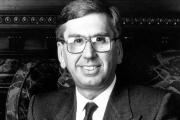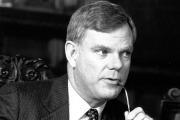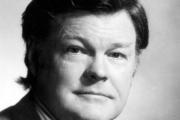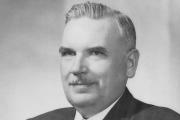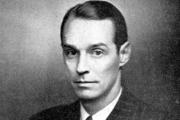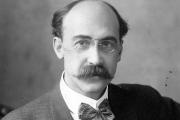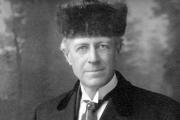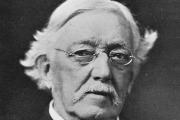Explore the history of Emerson College through our past presidents.
Dr. William (Bill) Gilligan, Interim President (2021–2023)
Dr. William (Bill) Gilligan, professor emeritus, returned to Emerson to serve as interim president after retiring from the position of vice president for information technology in 2020. He began his career at Emerson as an assistant professor in 1984.
Among his many achievements during his tenure, Gilligan facilitated the President’s Campus Task Force on Diversity in 2008 and worked closely with other senior administrators, architectural firm Elkus Manfredi, engineers, and technology vendors to design, build, and equip two professional-quality television studios in the new Tufte Performance and Production Center, as well as collaborated with technology vendors to design, build, and equip professional-quality Journalism facilities.
President Gilligan earned a bachelor’s degree in economics from Boston College, an MS in teaching from the University of New Hampshire, and an EdD in mathematics from Boston University. He was treasurer of the ECC-AAUP union chapter from 1985 to 1987 and a member of the Faculty Council for many years and chair of Faculty Assembly from 1992 to 1994, as well as the Faculty Athletics Representative to the NCAA on multiple occasions (1991–1994, 2005–2007).
M. Lee Pelton, 12th President (2011-2021)
Under Pelton’s leadership, Emerson expanded its academic footprint beyond its campuses in Boston, Los Angeles, and the Netherlands by establishing new global programs around the world. He also established an ambitious plan to strengthen Emerson’s sense of place and identity, as part of a redevelopment of downtown Boston, by animating the streetscape adjacent to the downtown Boston campus in order to inspire, embrace, and celebrate the city’s emerging diversity. Among the projects completed was the historic renovation of the 13-story Little Building residence hall with ground-level retail spaces as the cornerstone.
Pelton oversaw the creation of several new initiatives, including the creation of a Business of Creative Enterprises major; the first of its kind Comedic Arts major in higher education; the Office of Research and Creative Scholarship, which has set successive annual records for the number of grants and grant funds awarded to the College for innovative scholarly pursuits; the Office of Internationalization and Global Engagement, which supports faculty and research exchanges and strategic partnerships with universities abroad; HowlRound, an international center of online communication and collaboration tools for developing new theatrical work; the Elma Lewis Center for Civic Engagement, Learning, and Research; the opening of the Emerson College Los Angeles (2014) living and learning facility in the heart of Hollywood on Sunset Boulevard; and a partnership between the College and leading theatre producer Ambassador Theatre Group (ATG), to operate the Emerson Colonial Theatre with a goal to restore the theatre’s status as a try-out stage for Broadway shows.
Pelton also spearheaded an alliance with Marlboro College in Vermont, finalized in 2020, which moved Marlboro’s academic program, known for its self-directed nature, to Emerson, renaming Emerson’s liberal arts and interdisciplinary studies program to the Marlboro Institute for Liberal Arts and Interdisciplinary Studies.
Pelton is the current CEO & President of The Boston Foundation, one of the nation’s leading philanthropic organizations.
Jacqueline Weis Liebergott, 11th President (1992–2011)
In 2003, the College completed a full restoration of the Majestic Theatre and in 2010 reopened the Paramount Theatre as a live performance venue. The restoration of these two theaters culminated in the creation of ArtsEmerson, which showcases first-class performances of theater, film, and music from all over the world. Liebergott revitalized the Athletics Department by building Emerson’s first gymnasium in the Piano Row residence hall in 2006 and partnering with the City of Boston to refurbish Rotch Playground.
John Zacharis, 10th President (1989–1992)
Allen Koenig, 9th President (1979–1989)
During his presidency, Koenig worked to secure land in Lawrence, Massachusetts, in a bid to build an entirely new and unified campus. But by 1989, a move to Lawrence was deemed unfeasible, due to financial constraints and dissent from the Emerson community. Despite the failed bid to move Emerson out of Boston, Koenig was still able to expand the College’s reach. In 1985, a formal overseas program began in the Netherlands at Kasteel Well, purchased by Emerson in 1988. In 1986, Emerson began its Los Angeles program for students seeking internships and networking opportunities on the West Coast; the program continues to this day.
Gus Turbeville, 8th President (1975–1977)
Richard Chapin, 7th President (1967–1975)
Samuel Justus McKinley, 6th President (1952–1967)
McKinley returned to Emerson at a time when the College was in financial crisis and on the brink of collapse. Student morale was terrible and plagiarism was rampant. To combat these problems, he boosted student morale by attending every student production and making himself more visible and available to the student body. He also stressed the importance of academics over social clubs and extracurricular activities. He created two new departments, Broadcasting and Speech Therapy, both outgrowths of the Speech Department. In 1953, the College created the Samuel D. Robbins Speech Clinic in honor of the Emerson faculty member who started the Speech Department in 1935. That same year, the Broadcasting Department began offering courses in television production, and in 1954 the College built a state-of-the-art television studio. McKinley embarked on several successful fundraising campaigns throughout his term in office, which allowed the College to become financially stable and purchase several buildings. In 1965, Emerson acquired the Deertrees Theatre in Harrison, Maine, which served as a summer theater for Emerson students as well as students from other institutions.



